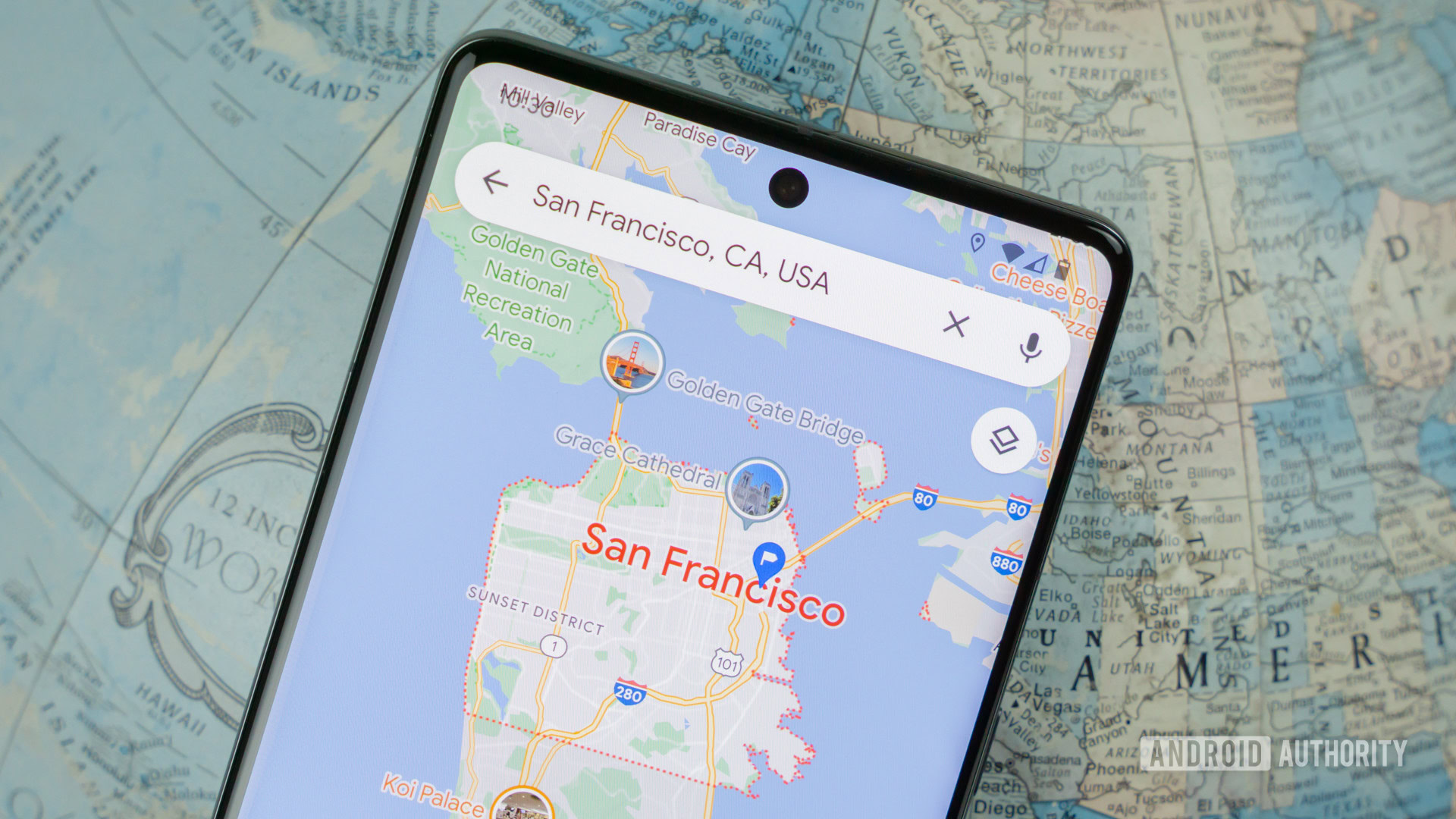
Edgar Cervantes / Android Authority
Google Maps and Apple Maps are two of the most widely used navigation apps today, offering a range of features to make traveling easier and more convenient. However, each app has its unique strengths and weaknesses. In this Google Maps vs Apple Maps showdown, we’ll compare both apps’ features, user interface, navigation accuracy, car integration, and more.
Google Maps vs Apple Maps
If you own an Android phone, you’ve likely been using Google Maps, which is pre-installed on most devices. Although, it can be easily downloaded from the Apple App Store for iOS devices. On the other hand, while Apple Maps is a native app on iOS devices, it is not officially available for Android devices through the Google Play Store. However, there are workarounds to access Apple Maps using web-based solutions, though the experience may not be as seamless or feature-rich as on an iOS device.
Already, Google Maps gets bonus points for near-universal availability. While the decision between Apple Maps vs Google Maps is likely faced more often by iPhone users, the comparison between navigation apps is still a worthwhile investigation regardless of which device you have. Let’s find out which app does a better job of getting you from point A to Point B.
Features and Abilities
Google Maps offers various features such as real-time traffic updates, voice-guided navigation, offline maps, Street View for an on-the-ground first-person perspective, and live location. It also integrates with Google services like Google Assistant for hands-free control and Google Earth for satellite imagery.
Apple Maps, on the other hand, has similar features like real-time traffic, voice-guided navigation, offline maps, and Look Around. However, it also includes Apple-specific features like indoor maps for public places like airports, Flyover for a drone-like view of major landmarks and cities, and Siri integration for hands-free control. Both apps use a dark mode to make it easier for your eyes during late-night driving.
User Interface
Both Google Maps and Apple Maps have user-friendly interfaces. Google Maps is a bit more cluttered, with more information displayed on the screen at once. Along the top screen is the search bar, with your account profile accessible from the left. Below you’ll find dedicated buttons for things like restaurants or gas stations, which can be helpful.
At the bottom of the screen is a menu to access the Explore and Commute features, saved locations, local news, and the option to contribute reviews and feedback for local amenities. If you find it all a bit much, you can tap the center of the screen, and it will all disappear.
In contrast, Apple Maps starts off with a cleaner and more minimalist interface, which some users find easier to navigate. Recent search history, saved destinations, and information about local businesses only pop up when you expand the search bar. In a way, it’s nice to have everything in one place, even if it is all truncated.
Both apps will reveal more information the further you zoom in on a location, but Apple Maps does start to show you data a little earlier on the zoom. You’ll find all the essentials, like road closures, landmarks, and your current location scanning the terrain.
Navigation Accuracy
Both apps are pretty similar in how they direct you to your destination. They both show you current time estimates and provide turn-by-turn navigation along your route. Plus, each app has directions for drivers, walkers, cyclists, and those traveling by public transport. However, Google Maps tends to have better navigation accuracy due to its extensive database and years of experience in mapping technology.
Apple Maps has improved significantly in recent years but may still fall short in certain areas, particularly regions with limited mapping data. Like Google, Apple Maps will suggest alternate routes if your current path becomes congested; it just won’t give you as many options as Google Maps. It’s worth noting that when it comes to finding the fastest way through traffic, both apps are outdone by Waze, a popular community-based navigation app.
Google Maps has one advantage in route planning: letting you add multiple custom stops before you depart. Apple Maps does allow you to add pit stops mid-route, but it is limited to things like gas stations or restaurants, not custom pins.
Traffic Information
Both Google Maps and Apple Maps offer real-time traffic information and let you report problems on the road, such as accidents or speed cameras. However, Google Maps has more accurate and comprehensive traffic data. This is due to Google’s extensive historical and real-time data; a large part comes from its integration with Waze.
Google Maps also has the advantage of saving specific commutes and showing you how busy those roads are on any given day, allowing you to adjust your departure or arrival time within the app. Apple Maps lets you save locations but does not offer departure time changes. The only solution on iPhone is to create a separate calendar event with the travel time feature enabled, which is a bit convoluted.
Public Transport
Google Maps’ robust public transportation system offers comprehensive information on transit routes, schedules, and estimated travel times. Apple Maps has improved its public transport information in recent years, but it still lags behind Google Maps in terms of coverage and accuracy. It can tell you the location of, say, a bus that’s en route, but it can’t tell you how crowded that bus is, which Google Maps can. Either way, they’ll both tell you what stop to get off at and suggest alternative ride-share options.
Assistant Integration
Google Maps integrates seamlessly with Google Assistant, enabling voice commands and personalized recommendations based on your Google account. Apple Maps integrates with Siri, offering a similar experience for iPhone users. Both assistants offer comparable functionality, with the choice mainly coming down to personal preference and ecosystem loyalty.
Siri does work with Google Maps, but you will have to specify which app you want directions from, or else it will default to Apple Maps. You can turn Siri off and download and set up Google Assistant on your iPhone, so you don’t have to say “directions to X from Google Maps” every time, but it is a bit of a hassle either way.
Street View vs Look Around
Google Maps Street View provides panoramic street-level imagery, allowing users to explore locations virtually from a first-person perspective. Apple Maps’ Look Around offers a similar feature with high-resolution, 3D imagery. Both are valuable alternatives to the typical top-down view of maps that give you a better sense of the terrain, especially while traveling to new areas.
While both features serve the same purpose, Google Maps has more extensive coverage since it has been around since 2007. More users have had more time to contribute images from streets worldwide. Apple’s Look Around has only been around since 2019, and the number of places you can actually use the feature is far less. Google had a head start and has managed to document more places, but Apple Maps should catch up to be just as robust with time.
Business Information
Both Google Maps and Apple Maps offer detailed business information, including addresses, phone numbers, hours of operation, and customer reviews. With Google Maps, you’ll find discovery options for specific categories below the search bar and a general overview of everything available from the Explore tab at the bottom. Apple Maps has a Fine Nearby feature that works similarly to Explore, but the information is paltry in comparison.
Google Maps has a more extensive database due to crowdsourcing user contributions through reviews and ratings. Contact information, opening hours, menus, and more are all at your fingertips. Also, because Google knows where people are at any moment, it can estimate how busy a place is, which is helpful if you want to avoid crowds.
Apple Maps has curated guides that source relevant editorial content online to help familiarize you with an area, which can sometimes provide higher-quality recommendations. Still, you certainly get more quantity of user feedback and tips from Google Maps discovery.
Privacy
Apple Maps is known for its strong focus on user privacy, with features like on-device data processing and randomized identifiers to prevent tracking. Apple doesn’t store any information about where you’ve been or what you’ve been searching for; none of that information is associated with your Apple ID.
While offering some privacy features, Google Maps relies more on user data to personalize the experience and usually shares more information with third parties to better personalize Google’s ads. Your Google Account is linked to everything you do on Google Maps, meaning personal data is stored in Google’s servers, not your device like Apple Maps.
Car Integration
Google Maps is available on Android Auto, while Apple Maps works with Apple CarPlay. Both systems offer a similar experience: voice-guided navigation and easy access to music and communication apps on their vehicle’s infotainment system. Android Auto and Apple CarPlay are available on many car models and work seamlessly with your vehicle’s controls. The choice between the two largely depends on your smartphone platform and personal preferences.
Google Maps vs Apple Maps: Which one is right for you?
Both Google Maps and Apple Maps offer a range of features to make navigation and travel more convenient. While Google Maps has an edge in areas like traffic information, public transport, and business information, Apple Maps shines in terms of privacy, user interface, and seamless integration with the Apple ecosystem. Ultimately, the choice between Google Maps and Apple Maps comes down to personal preference, the devices you use, and the specific features you prioritize. It’s worth trying both apps to see which one best suits your needs and preferences.
Which navigation app do you prefer?
85 votes
FAQs
Yes, you can use Google Maps on Apple CarPlay. To do this, you must install the Google Maps app on your iPhone and a CarPlay-compatible vehicle. Once connected, you can select Google Maps from the CarPlay interface to use it for navigation.
Yes, you can use Google Maps on Apple Watches with WatchOS 5 or higher and iOS 10 or higher. You must also turn on location services to use Google Maps on your Apple Watch.
Apple Maps is not officially available for Android devices through the Google Play Store. However, there are workarounds to access Apple Maps using third-party apps or web-based solutions, but the experience is not as seamless or feature-rich as on an iOS device.



